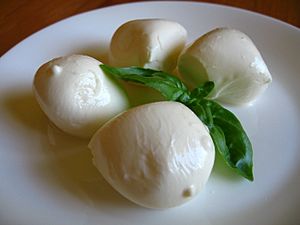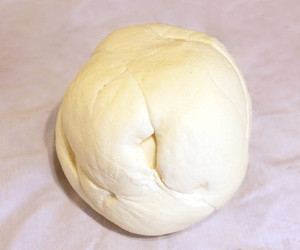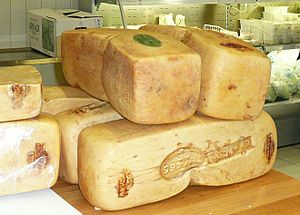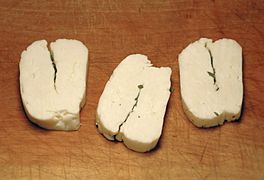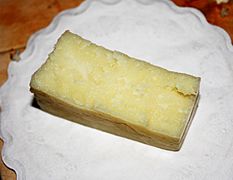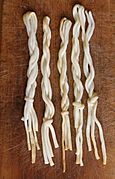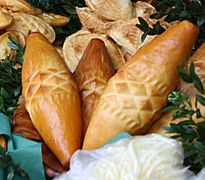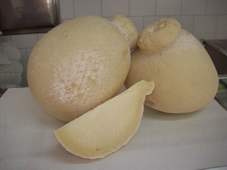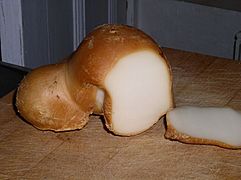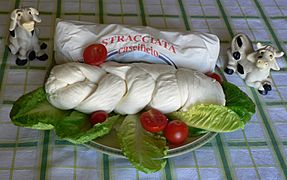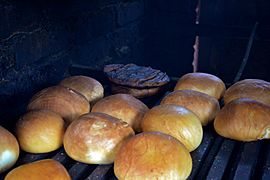List of stretch-curd cheeses facts for kids
This article is about stretch-curd cheeses. These are special cheeses made using a technique called pasta filata. This Italian name means "spun paste."
To make these cheeses, the fresh cheese curds (the solid bits of milk that separate from the liquid) are put into hot water. Then, they are kneaded and stretched. This process makes the cheese smooth and often a bit stringy. It also gives these cheeses their unique texture.
Types of Stretch-Curd Cheeses
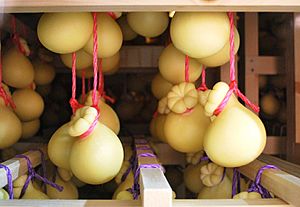
Straddled forms of caciocavallo hang to age
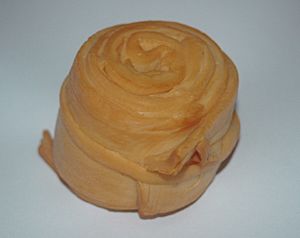
Smoked Parenica
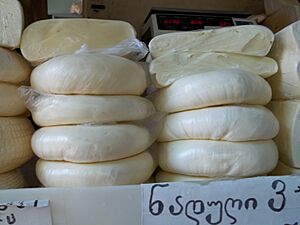
Discs of Sulguni
- Akkawi – This is a white, salty cheese from Acre, Israel. It feels a bit like mozzarella or feta cheese. Akkawi doesn't melt easily, which makes it great for cooking.
- Braided cheese – As the name suggests, this cheese is made from long strips of stretchy cheese woven together like a braid! You can find different kinds of braided cheese in Turkey, Armenia, Lebanon, Syria, and many countries in Latin America.
- Caciocavallo – This cheese is made from sheep's or cow's milk. It's popular in Southern Italy, especially in the Apennine Mountains. Caciocavallo often looks like a tear-drop and has a hard outer skin. It tastes similar to aged Provolone cheese.
- Galbanino – This is a soft, mild cheese from Italy, made by the company Galbani. It tastes a lot like a mild Provolone cheese.
- Halloumi – Halloumi is a semi-hard, salty cheese from Cyprus. It's usually made from a mix of goat's and sheep's milk, and sometimes cow's milk too. Halloumi is special because it doesn't melt easily when you cook it, making it perfect for grilling or frying!
- Kashkaval – This is a hard, yellow cheese made from cow's milk, sheep's milk, or both. It's been around for a long time, since the 11th and 12th centuries, and is popular in many Mediterranean countries.
- Mozzarella – Mozzarella is a very famous cheese from Southern Italy. It's made using the pasta filata method, which gives it its stretchy texture.
- Bocconcini – These are small mozzarella cheeses, about the size of an egg. They are made by dipping the cheese curds into hot liquid, then kneading and stretching them.
- Buffalo mozzarella – This special mozzarella is made from the milk of Mediterranea Italiana buffalo. It's traditionally made in the Campania region of Italy.
- Oaxaca cheese – This is a white, semi-hard cheese from Mexico. It's similar to a mild Monterey Jack cheese, but it has a stringy texture like mozzarella. Making it involves stretching the cheese into long ribbons and then rolling it up into a ball, like a ball of yarn!
- Oscypek – This is a unique smoked cheese from the Tatra Mountains in Poland. It's made from salted sheep's milk, sometimes with a little cow's milk. The cheese is pressed into decorative, spindle-shaped wooden molds. Then, it's soaked in salty water and finally smoked for up to two weeks in a special hut.
- Oštiepok – This is another traditional smoked sheep's milk cheese, but this one is from Slovakia. It's a protected cheese name in the EU.
- Pallone di Gravina – This is a firm cow's milk cheese from southern Italy. It's made in the pasta filata style and often shaped like a pear, ball, or balloon (pallone means "balloon" in Italian). It usually weighs between 1.5 and 2.5 kilograms (about 3 to 5.5 pounds).
- Parenica – This is a traditional Slovak cheese that is semi-firm and often smoked. It's also a protected cheese name in the EU. You can find both smoked and unsmoked versions.
- Provolone – This is an aged, semi-hard Italian cheese. It comes in different shapes like pears, sausages, or cones. Provolone can taste very different depending on how long it's aged.
- Provolone piccante is aged for at least four months and has a very sharp taste.
- Provolone dolce is sweet and has a very mild taste.
- Ragusano cheese – This Italian cow's milk cheese comes from the Ragusa in Sicily, southern Italy. It's a firm, stretched-curd cheese made from the milk of Modicana cows. These cows eat only fresh grass or hay. This cheese has special protection from the EU.
- Scamorza – This is an Italian stretched-curd cheese, usually made from cow's milk. After the cheese curds mature, cheese makers often tie a string around the cheese and hang it to dry. This gives it a pear-like shape.
- Stracciata – This fresh cow's milk cheese from Italy is made into flat strips, about 4–5 centimeters (about 1.5-2 inches) wide and 1 centimeter (about 0.4 inches) thick. The name "stracciata" means "tattered" in Italian, because the strips are folded or woven.
- Stracciatella di bufala – This cheese is made from Italian buffalo milk in southern Italy. It's made by stretching and shredding the cheese.
- String cheese – This is a general name for cheeses where the way they are made lines up the proteins, making the cheese easy to pull apart into strings!
- Chechil – This is a salty string cheese that started in Armenia. It's similar to mozzarella or sulguni. It's often made into dense strings, rolled up in a figure eight, or braided into thick ropes.
- Korbáčik – This is a semi-hard string cheese woven into fine braids. It comes from the Orava region of northern Slovakia. Korbáčik comes in smoked and unsmoked versions.
- Sulguni – This is a salty cheese from the Samegrelo region of Georgia. It has a slightly sour, salty taste and a springy texture. These qualities come from how it's made, which is why it's sometimes called "pickle cheese." Fried sulguni is a popular dish in Georgia.
Gallery
- Stretch-curd cheeses
-
Korbáčik is a type of braided cheese.
-
Traditional Oscypek
-
Provolone dolce (sweet provolone)
See also

All content from Kiddle encyclopedia articles (including the article images and facts) can be freely used under Attribution-ShareAlike license, unless stated otherwise. Cite this article:
List of stretch-curd cheeses Facts for Kids. Kiddle Encyclopedia.

